Big Data Technology: Supporting Business with Analytics Report
VerifiedAdded on 2023/06/14
|6
|1836
|171
Report
AI Summary
This report provides a comprehensive overview of big data, including its characteristics, challenges, and techniques for analysis. It highlights how big data technology supports businesses by facilitating decision-making, improving customer understanding, and enabling automation. The report discusses the importance of data mining, data integration, and A/B testing in analyzing large datasets. It also addresses key challenges such as specialist deficiency, data growth issues, data security, and the lack of understanding of big data. The conclusion emphasizes the essential role of big data in enterprise development and the importance of understanding information for effective decision-making. Desklib offers similar solved assignments and past papers for students.
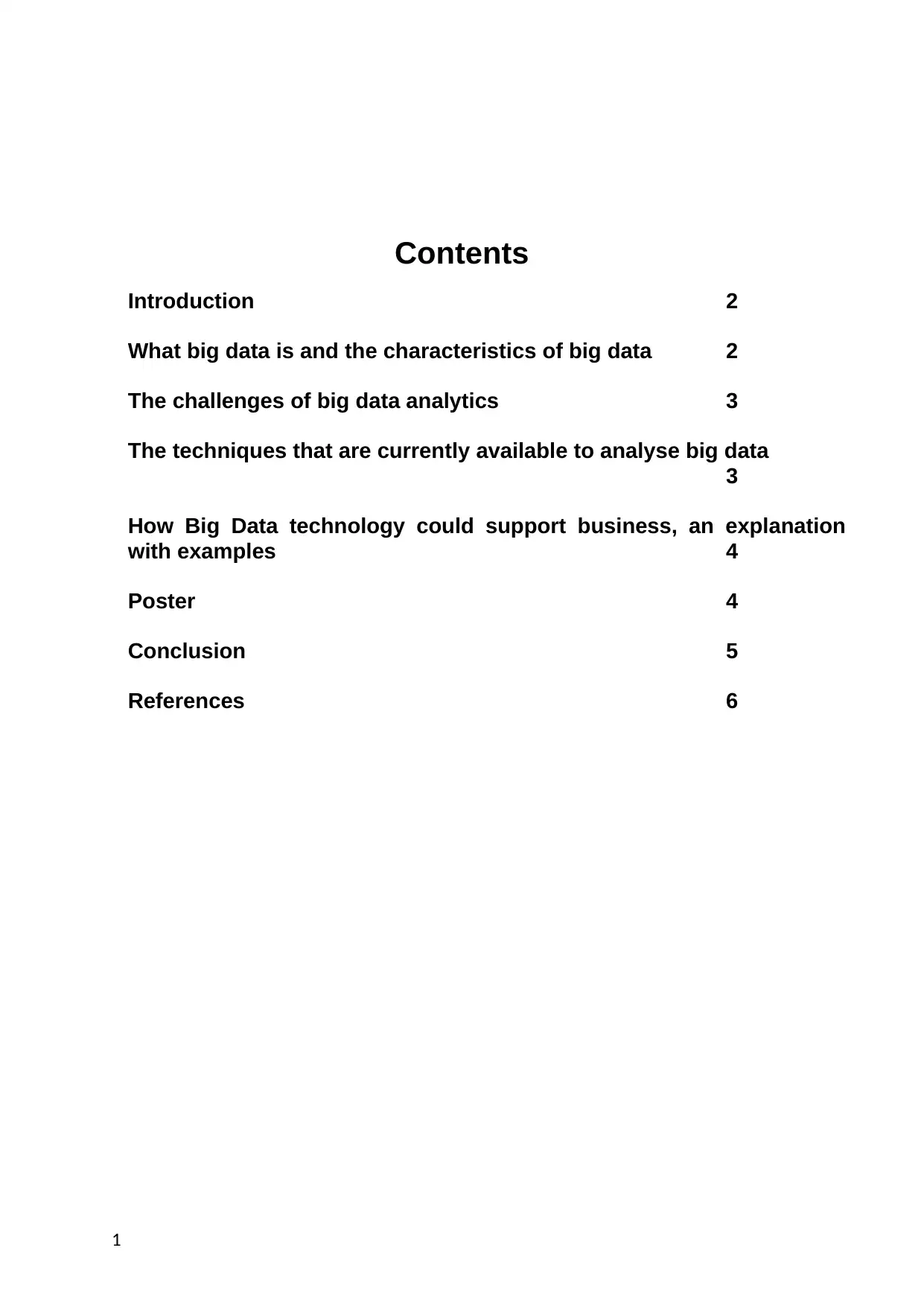
Contents
Introduction 2
What big data is and the characteristics of big data 2
The challenges of big data analytics 3
The techniques that are currently available to analyse big data
3
How Big Data technology could support business, an explanation
with examples 4
Poster 4
Conclusion 5
References 6
1
Introduction 2
What big data is and the characteristics of big data 2
The challenges of big data analytics 3
The techniques that are currently available to analyse big data
3
How Big Data technology could support business, an explanation
with examples 4
Poster 4
Conclusion 5
References 6
1
Paraphrase This Document
Need a fresh take? Get an instant paraphrase of this document with our AI Paraphraser
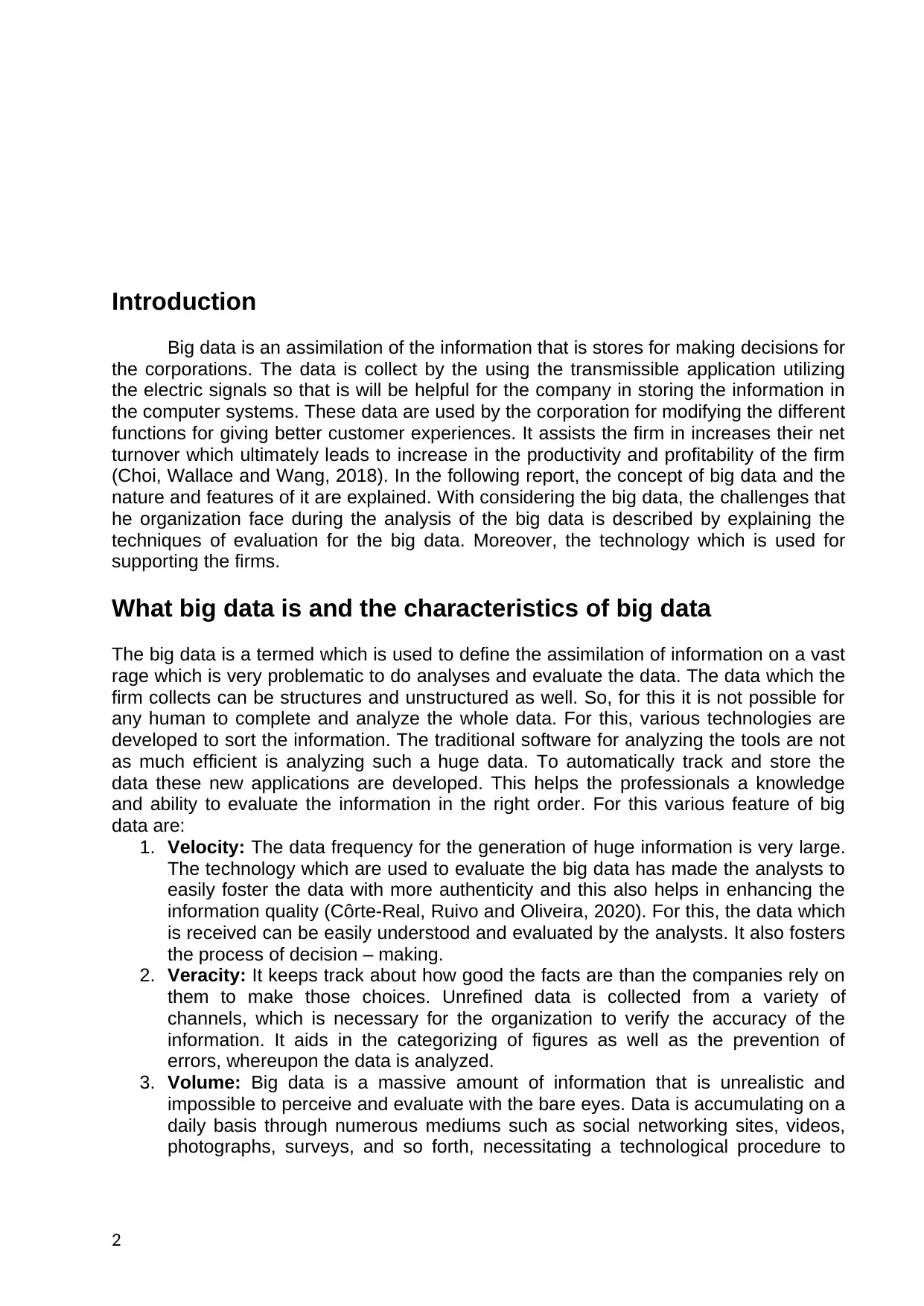
Introduction
Big data is an assimilation of the information that is stores for making decisions for
the corporations. The data is collect by the using the transmissible application utilizing
the electric signals so that is will be helpful for the company in storing the information in
the computer systems. These data are used by the corporation for modifying the different
functions for giving better customer experiences. It assists the firm in increases their net
turnover which ultimately leads to increase in the productivity and profitability of the firm
(Choi, Wallace and Wang, 2018). In the following report, the concept of big data and the
nature and features of it are explained. With considering the big data, the challenges that
he organization face during the analysis of the big data is described by explaining the
techniques of evaluation for the big data. Moreover, the technology which is used for
supporting the firms.
What big data is and the characteristics of big data
The big data is a termed which is used to define the assimilation of information on a vast
rage which is very problematic to do analyses and evaluate the data. The data which the
firm collects can be structures and unstructured as well. So, for this it is not possible for
any human to complete and analyze the whole data. For this, various technologies are
developed to sort the information. The traditional software for analyzing the tools are not
as much efficient is analyzing such a huge data. To automatically track and store the
data these new applications are developed. This helps the professionals a knowledge
and ability to evaluate the information in the right order. For this various feature of big
data are:
1. Velocity: The data frequency for the generation of huge information is very large.
The technology which are used to evaluate the big data has made the analysts to
easily foster the data with more authenticity and this also helps in enhancing the
information quality (Côrte-Real, Ruivo and Oliveira, 2020). For this, the data which
is received can be easily understood and evaluated by the analysts. It also fosters
the process of decision – making.
2. Veracity: It keeps track about how good the facts are than the companies rely on
them to make those choices. Unrefined data is collected from a variety of
channels, which is necessary for the organization to verify the accuracy of the
information. It aids in the categorizing of figures as well as the prevention of
errors, whereupon the data is analyzed.
3. Volume: Big data is a massive amount of information that is unrealistic and
impossible to perceive and evaluate with the bare eyes. Data is accumulating on a
daily basis through numerous mediums such as social networking sites, videos,
photographs, surveys, and so forth, necessitating a technological procedure to
2
Big data is an assimilation of the information that is stores for making decisions for
the corporations. The data is collect by the using the transmissible application utilizing
the electric signals so that is will be helpful for the company in storing the information in
the computer systems. These data are used by the corporation for modifying the different
functions for giving better customer experiences. It assists the firm in increases their net
turnover which ultimately leads to increase in the productivity and profitability of the firm
(Choi, Wallace and Wang, 2018). In the following report, the concept of big data and the
nature and features of it are explained. With considering the big data, the challenges that
he organization face during the analysis of the big data is described by explaining the
techniques of evaluation for the big data. Moreover, the technology which is used for
supporting the firms.
What big data is and the characteristics of big data
The big data is a termed which is used to define the assimilation of information on a vast
rage which is very problematic to do analyses and evaluate the data. The data which the
firm collects can be structures and unstructured as well. So, for this it is not possible for
any human to complete and analyze the whole data. For this, various technologies are
developed to sort the information. The traditional software for analyzing the tools are not
as much efficient is analyzing such a huge data. To automatically track and store the
data these new applications are developed. This helps the professionals a knowledge
and ability to evaluate the information in the right order. For this various feature of big
data are:
1. Velocity: The data frequency for the generation of huge information is very large.
The technology which are used to evaluate the big data has made the analysts to
easily foster the data with more authenticity and this also helps in enhancing the
information quality (Côrte-Real, Ruivo and Oliveira, 2020). For this, the data which
is received can be easily understood and evaluated by the analysts. It also fosters
the process of decision – making.
2. Veracity: It keeps track about how good the facts are than the companies rely on
them to make those choices. Unrefined data is collected from a variety of
channels, which is necessary for the organization to verify the accuracy of the
information. It aids in the categorizing of figures as well as the prevention of
errors, whereupon the data is analyzed.
3. Volume: Big data is a massive amount of information that is unrealistic and
impossible to perceive and evaluate with the bare eyes. Data is accumulating on a
daily basis through numerous mediums such as social networking sites, videos,
photographs, surveys, and so forth, necessitating a technological procedure to
2
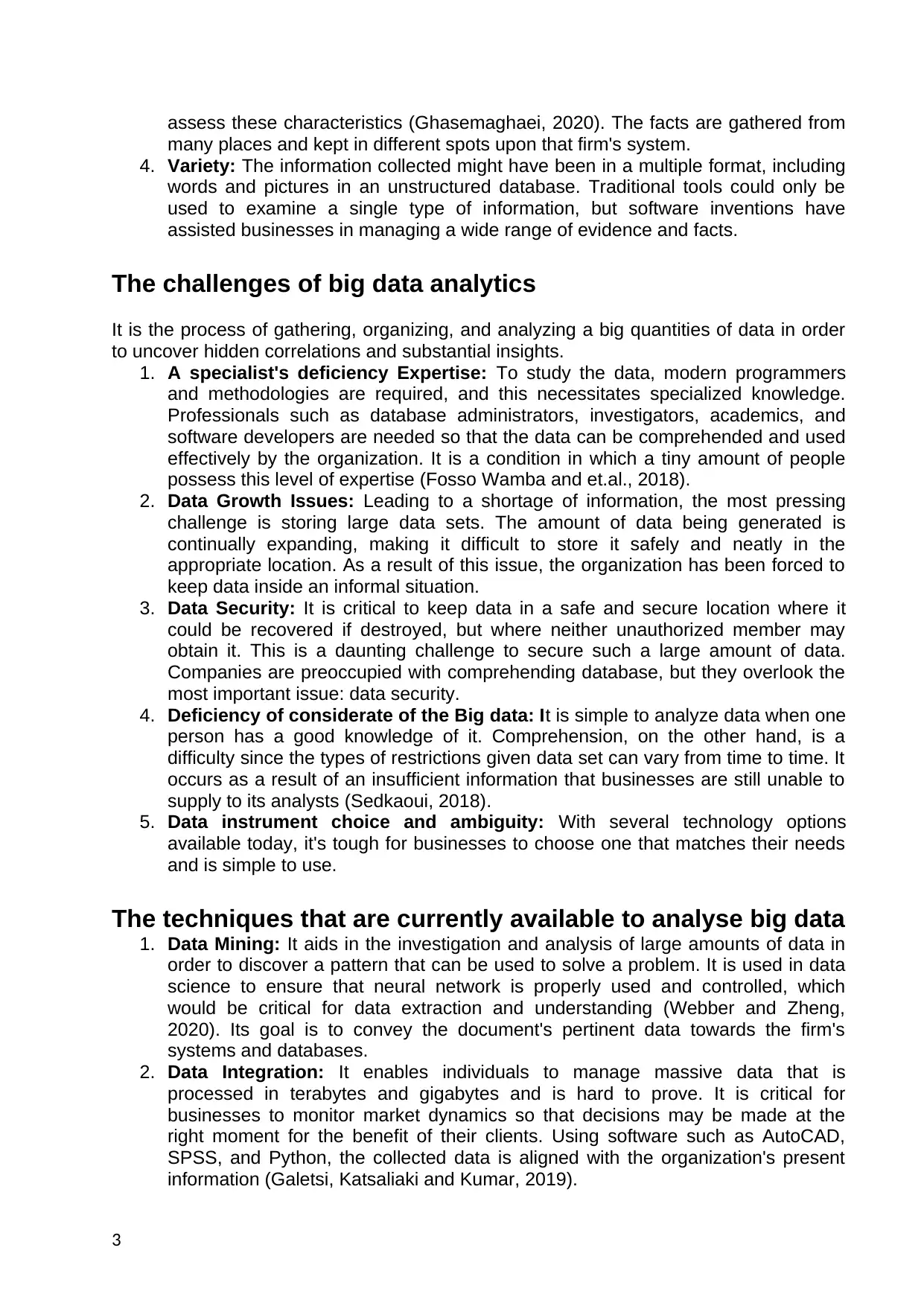
assess these characteristics (Ghasemaghaei, 2020). The facts are gathered from
many places and kept in different spots upon that firm's system.
4. Variety: The information collected might have been in a multiple format, including
words and pictures in an unstructured database. Traditional tools could only be
used to examine a single type of information, but software inventions have
assisted businesses in managing a wide range of evidence and facts.
The challenges of big data analytics
It is the process of gathering, organizing, and analyzing a big quantities of data in order
to uncover hidden correlations and substantial insights.
1. A specialist's deficiency Expertise: To study the data, modern programmers
and methodologies are required, and this necessitates specialized knowledge.
Professionals such as database administrators, investigators, academics, and
software developers are needed so that the data can be comprehended and used
effectively by the organization. It is a condition in which a tiny amount of people
possess this level of expertise (Fosso Wamba and et.al., 2018).
2. Data Growth Issues: Leading to a shortage of information, the most pressing
challenge is storing large data sets. The amount of data being generated is
continually expanding, making it difficult to store it safely and neatly in the
appropriate location. As a result of this issue, the organization has been forced to
keep data inside an informal situation.
3. Data Security: It is critical to keep data in a safe and secure location where it
could be recovered if destroyed, but where neither unauthorized member may
obtain it. This is a daunting challenge to secure such a large amount of data.
Companies are preoccupied with comprehending database, but they overlook the
most important issue: data security.
4. Deficiency of considerate of the Big data: It is simple to analyze data when one
person has a good knowledge of it. Comprehension, on the other hand, is a
difficulty since the types of restrictions given data set can vary from time to time. It
occurs as a result of an insufficient information that businesses are still unable to
supply to its analysts (Sedkaoui, 2018).
5. Data instrument choice and ambiguity: With several technology options
available today, it's tough for businesses to choose one that matches their needs
and is simple to use.
The techniques that are currently available to analyse big data
1. Data Mining: It aids in the investigation and analysis of large amounts of data in
order to discover a pattern that can be used to solve a problem. It is used in data
science to ensure that neural network is properly used and controlled, which
would be critical for data extraction and understanding (Webber and Zheng,
2020). Its goal is to convey the document's pertinent data towards the firm's
systems and databases.
2. Data Integration: It enables individuals to manage massive data that is
processed in terabytes and gigabytes and is hard to prove. It is critical for
businesses to monitor market dynamics so that decisions may be made at the
right moment for the benefit of their clients. Using software such as AutoCAD,
SPSS, and Python, the collected data is aligned with the organization's present
information (Galetsi, Katsaliaki and Kumar, 2019).
3
many places and kept in different spots upon that firm's system.
4. Variety: The information collected might have been in a multiple format, including
words and pictures in an unstructured database. Traditional tools could only be
used to examine a single type of information, but software inventions have
assisted businesses in managing a wide range of evidence and facts.
The challenges of big data analytics
It is the process of gathering, organizing, and analyzing a big quantities of data in order
to uncover hidden correlations and substantial insights.
1. A specialist's deficiency Expertise: To study the data, modern programmers
and methodologies are required, and this necessitates specialized knowledge.
Professionals such as database administrators, investigators, academics, and
software developers are needed so that the data can be comprehended and used
effectively by the organization. It is a condition in which a tiny amount of people
possess this level of expertise (Fosso Wamba and et.al., 2018).
2. Data Growth Issues: Leading to a shortage of information, the most pressing
challenge is storing large data sets. The amount of data being generated is
continually expanding, making it difficult to store it safely and neatly in the
appropriate location. As a result of this issue, the organization has been forced to
keep data inside an informal situation.
3. Data Security: It is critical to keep data in a safe and secure location where it
could be recovered if destroyed, but where neither unauthorized member may
obtain it. This is a daunting challenge to secure such a large amount of data.
Companies are preoccupied with comprehending database, but they overlook the
most important issue: data security.
4. Deficiency of considerate of the Big data: It is simple to analyze data when one
person has a good knowledge of it. Comprehension, on the other hand, is a
difficulty since the types of restrictions given data set can vary from time to time. It
occurs as a result of an insufficient information that businesses are still unable to
supply to its analysts (Sedkaoui, 2018).
5. Data instrument choice and ambiguity: With several technology options
available today, it's tough for businesses to choose one that matches their needs
and is simple to use.
The techniques that are currently available to analyse big data
1. Data Mining: It aids in the investigation and analysis of large amounts of data in
order to discover a pattern that can be used to solve a problem. It is used in data
science to ensure that neural network is properly used and controlled, which
would be critical for data extraction and understanding (Webber and Zheng,
2020). Its goal is to convey the document's pertinent data towards the firm's
systems and databases.
2. Data Integration: It enables individuals to manage massive data that is
processed in terabytes and gigabytes and is hard to prove. It is critical for
businesses to monitor market dynamics so that decisions may be made at the
right moment for the benefit of their clients. Using software such as AutoCAD,
SPSS, and Python, the collected data is aligned with the organization's present
information (Galetsi, Katsaliaki and Kumar, 2019).
3
⊘ This is a preview!⊘
Do you want full access?
Subscribe today to unlock all pages.

Trusted by 1+ million students worldwide
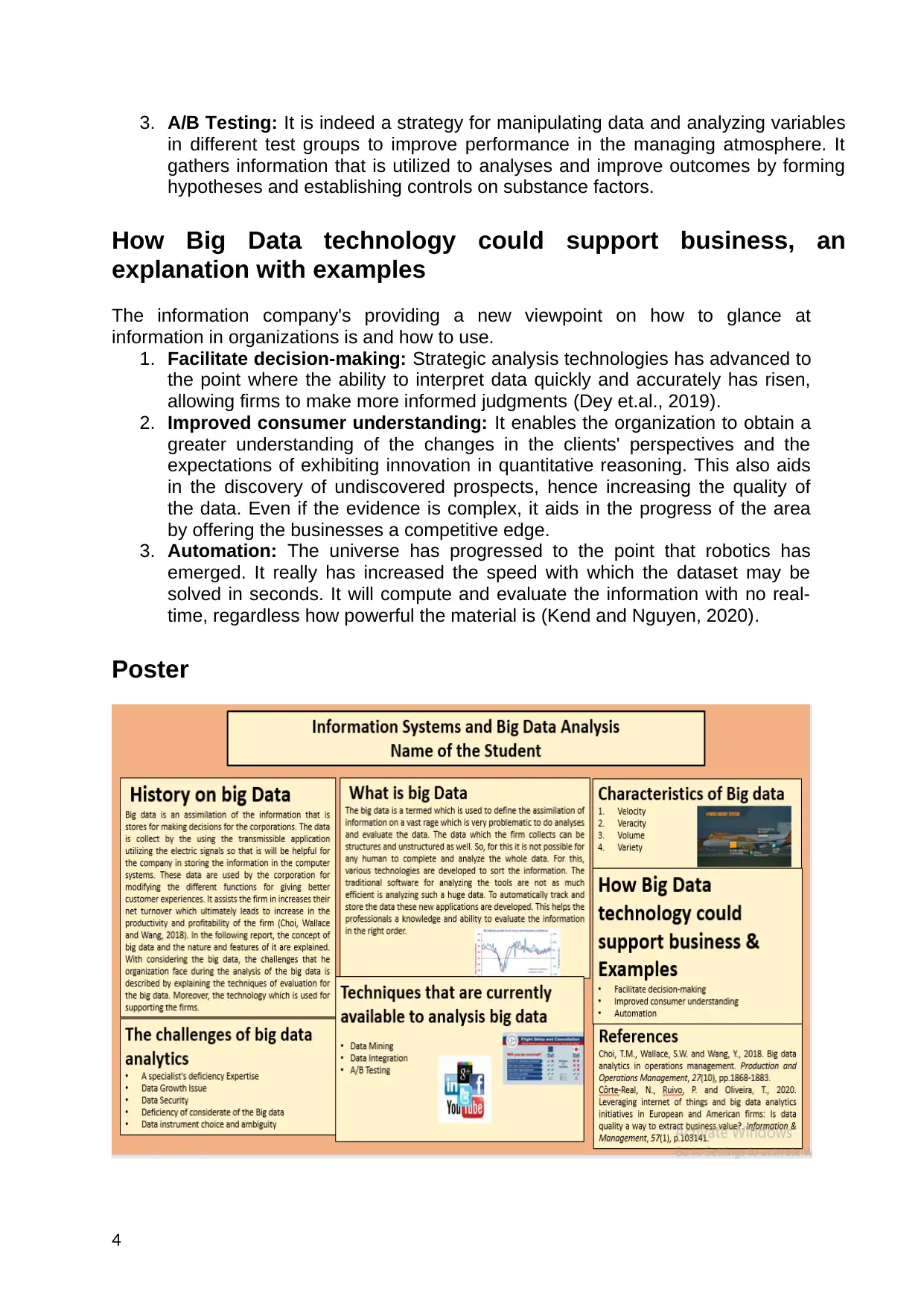
3. A/B Testing: It is indeed a strategy for manipulating data and analyzing variables
in different test groups to improve performance in the managing atmosphere. It
gathers information that is utilized to analyses and improve outcomes by forming
hypotheses and establishing controls on substance factors.
How Big Data technology could support business, an
explanation with examples
The information company's providing a new viewpoint on how to glance at
information in organizations is and how to use.
1. Facilitate decision-making: Strategic analysis technologies has advanced to
the point where the ability to interpret data quickly and accurately has risen,
allowing firms to make more informed judgments (Dey et.al., 2019).
2. Improved consumer understanding: It enables the organization to obtain a
greater understanding of the changes in the clients' perspectives and the
expectations of exhibiting innovation in quantitative reasoning. This also aids
in the discovery of undiscovered prospects, hence increasing the quality of
the data. Even if the evidence is complex, it aids in the progress of the area
by offering the businesses a competitive edge.
3. Automation: The universe has progressed to the point that robotics has
emerged. It really has increased the speed with which the dataset may be
solved in seconds. It will compute and evaluate the information with no real-
time, regardless how powerful the material is (Kend and Nguyen, 2020).
Poster
4
in different test groups to improve performance in the managing atmosphere. It
gathers information that is utilized to analyses and improve outcomes by forming
hypotheses and establishing controls on substance factors.
How Big Data technology could support business, an
explanation with examples
The information company's providing a new viewpoint on how to glance at
information in organizations is and how to use.
1. Facilitate decision-making: Strategic analysis technologies has advanced to
the point where the ability to interpret data quickly and accurately has risen,
allowing firms to make more informed judgments (Dey et.al., 2019).
2. Improved consumer understanding: It enables the organization to obtain a
greater understanding of the changes in the clients' perspectives and the
expectations of exhibiting innovation in quantitative reasoning. This also aids
in the discovery of undiscovered prospects, hence increasing the quality of
the data. Even if the evidence is complex, it aids in the progress of the area
by offering the businesses a competitive edge.
3. Automation: The universe has progressed to the point that robotics has
emerged. It really has increased the speed with which the dataset may be
solved in seconds. It will compute and evaluate the information with no real-
time, regardless how powerful the material is (Kend and Nguyen, 2020).
Poster
4
Paraphrase This Document
Need a fresh take? Get an instant paraphrase of this document with our AI Paraphraser
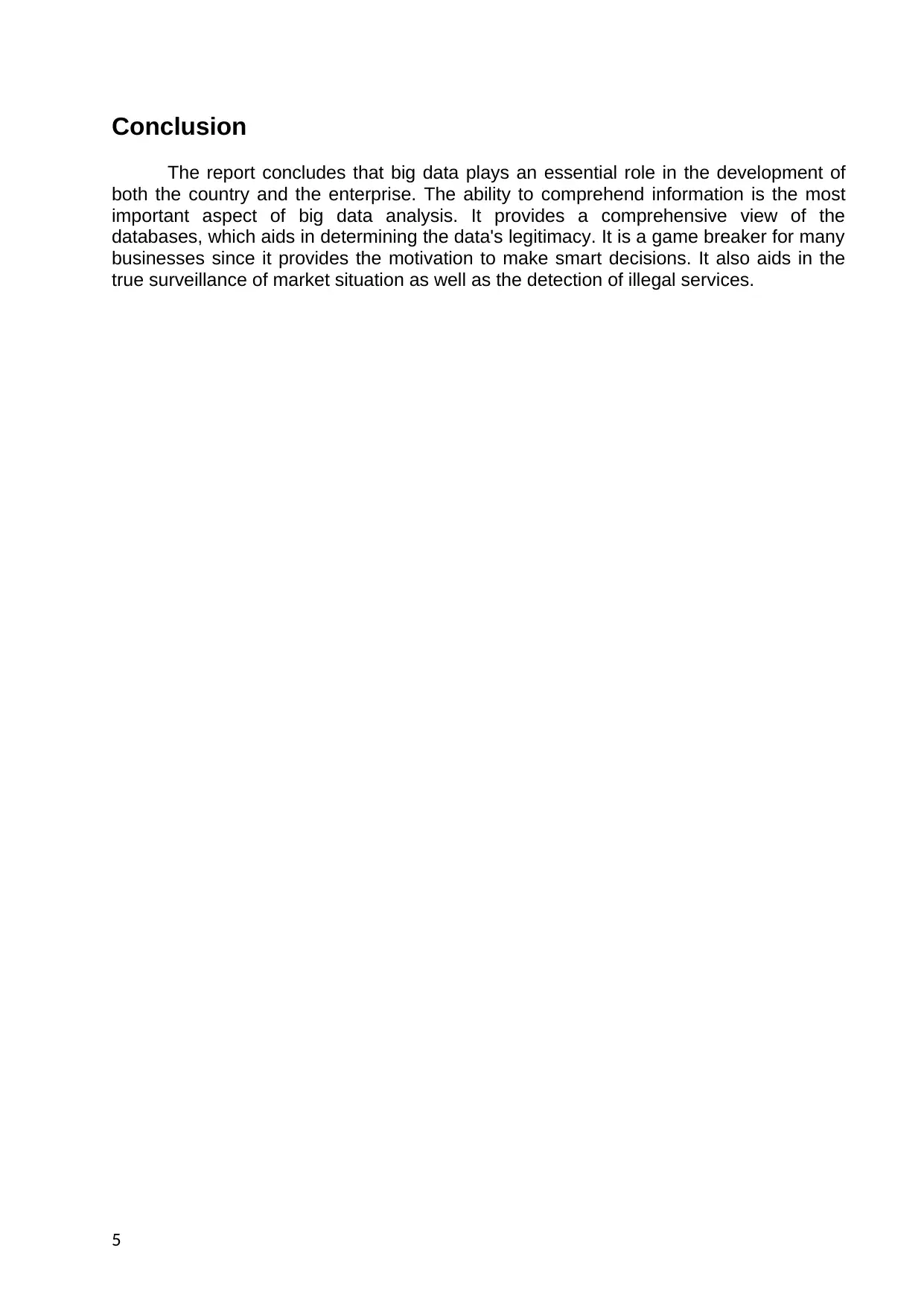
Conclusion
The report concludes that big data plays an essential role in the development of
both the country and the enterprise. The ability to comprehend information is the most
important aspect of big data analysis. It provides a comprehensive view of the
databases, which aids in determining the data's legitimacy. It is a game breaker for many
businesses since it provides the motivation to make smart decisions. It also aids in the
true surveillance of market situation as well as the detection of illegal services.
5
The report concludes that big data plays an essential role in the development of
both the country and the enterprise. The ability to comprehend information is the most
important aspect of big data analysis. It provides a comprehensive view of the
databases, which aids in determining the data's legitimacy. It is a game breaker for many
businesses since it provides the motivation to make smart decisions. It also aids in the
true surveillance of market situation as well as the detection of illegal services.
5
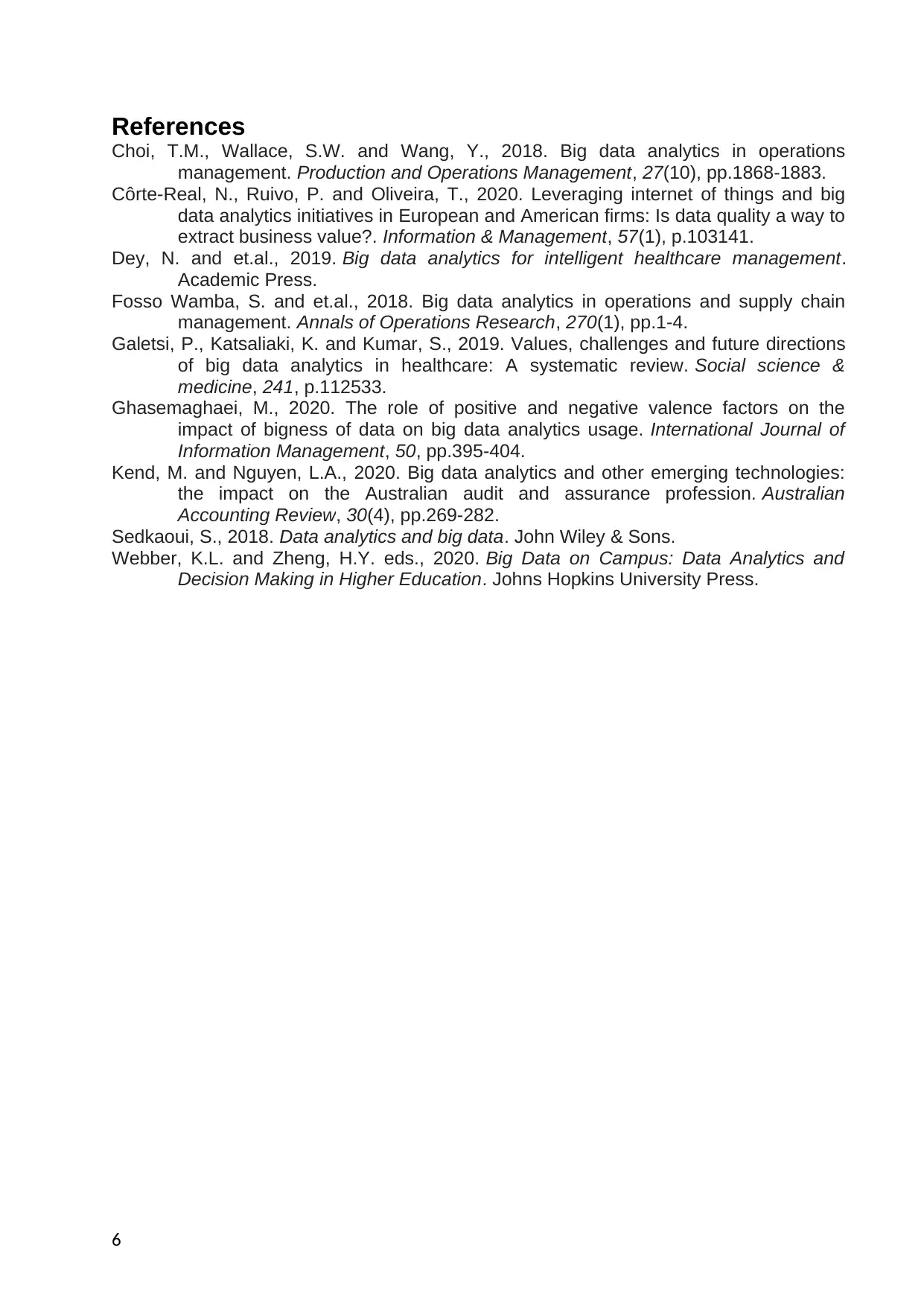
References
Choi, T.M., Wallace, S.W. and Wang, Y., 2018. Big data analytics in operations
management. Production and Operations Management, 27(10), pp.1868-1883.
Côrte-Real, N., Ruivo, P. and Oliveira, T., 2020. Leveraging internet of things and big
data analytics initiatives in European and American firms: Is data quality a way to
extract business value?. Information & Management, 57(1), p.103141.
Dey, N. and et.al., 2019. Big data analytics for intelligent healthcare management.
Academic Press.
Fosso Wamba, S. and et.al., 2018. Big data analytics in operations and supply chain
management. Annals of Operations Research, 270(1), pp.1-4.
Galetsi, P., Katsaliaki, K. and Kumar, S., 2019. Values, challenges and future directions
of big data analytics in healthcare: A systematic review. Social science &
medicine, 241, p.112533.
Ghasemaghaei, M., 2020. The role of positive and negative valence factors on the
impact of bigness of data on big data analytics usage. International Journal of
Information Management, 50, pp.395-404.
Kend, M. and Nguyen, L.A., 2020. Big data analytics and other emerging technologies:
the impact on the Australian audit and assurance profession. Australian
Accounting Review, 30(4), pp.269-282.
Sedkaoui, S., 2018. Data analytics and big data. John Wiley & Sons.
Webber, K.L. and Zheng, H.Y. eds., 2020. Big Data on Campus: Data Analytics and
Decision Making in Higher Education. Johns Hopkins University Press.
6
Choi, T.M., Wallace, S.W. and Wang, Y., 2018. Big data analytics in operations
management. Production and Operations Management, 27(10), pp.1868-1883.
Côrte-Real, N., Ruivo, P. and Oliveira, T., 2020. Leveraging internet of things and big
data analytics initiatives in European and American firms: Is data quality a way to
extract business value?. Information & Management, 57(1), p.103141.
Dey, N. and et.al., 2019. Big data analytics for intelligent healthcare management.
Academic Press.
Fosso Wamba, S. and et.al., 2018. Big data analytics in operations and supply chain
management. Annals of Operations Research, 270(1), pp.1-4.
Galetsi, P., Katsaliaki, K. and Kumar, S., 2019. Values, challenges and future directions
of big data analytics in healthcare: A systematic review. Social science &
medicine, 241, p.112533.
Ghasemaghaei, M., 2020. The role of positive and negative valence factors on the
impact of bigness of data on big data analytics usage. International Journal of
Information Management, 50, pp.395-404.
Kend, M. and Nguyen, L.A., 2020. Big data analytics and other emerging technologies:
the impact on the Australian audit and assurance profession. Australian
Accounting Review, 30(4), pp.269-282.
Sedkaoui, S., 2018. Data analytics and big data. John Wiley & Sons.
Webber, K.L. and Zheng, H.Y. eds., 2020. Big Data on Campus: Data Analytics and
Decision Making in Higher Education. Johns Hopkins University Press.
6
⊘ This is a preview!⊘
Do you want full access?
Subscribe today to unlock all pages.

Trusted by 1+ million students worldwide
1 out of 6
Related Documents
Your All-in-One AI-Powered Toolkit for Academic Success.
+13062052269
info@desklib.com
Available 24*7 on WhatsApp / Email
![[object Object]](/_next/static/media/star-bottom.7253800d.svg)
Unlock your academic potential
Copyright © 2020–2025 A2Z Services. All Rights Reserved. Developed and managed by ZUCOL.
